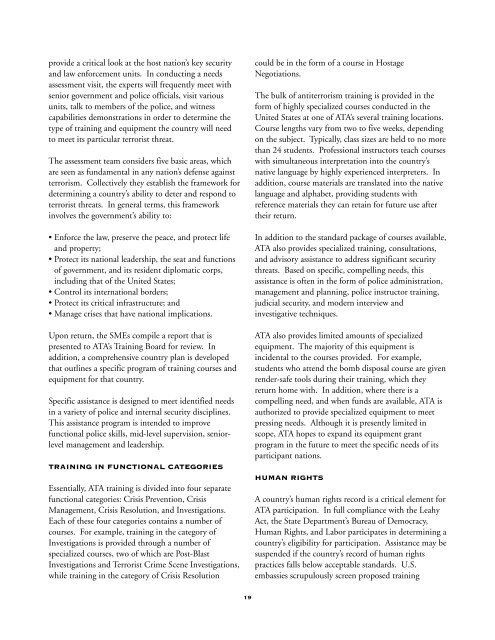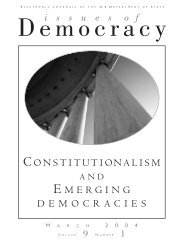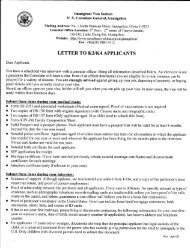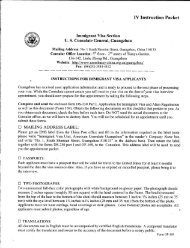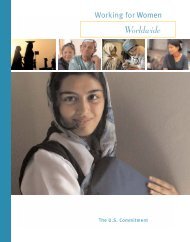Terrorism: Threat Assessment, Countermeasures and Policy
Terrorism: Threat Assessment, Countermeasures and Policy
Terrorism: Threat Assessment, Countermeasures and Policy
You also want an ePaper? Increase the reach of your titles
YUMPU automatically turns print PDFs into web optimized ePapers that Google loves.
provide a critical look at the host nation’s key security<br />
<strong>and</strong> law enforcement units. In conducting a needs<br />
assessment visit, the experts will frequently meet with<br />
senior government <strong>and</strong> police officials, visit various<br />
units, talk to members of the police, <strong>and</strong> witness<br />
capabilities demonstrations in order to determine the<br />
type of training <strong>and</strong> equipment the country will need<br />
to meet its particular terrorist threat.<br />
The assessment team considers five basic areas, which<br />
are seen as fundamental in any nation’s defense against<br />
terrorism. Collectively they establish the framework for<br />
determining a country’s ability to deter <strong>and</strong> respond to<br />
terrorist threats. In general terms, this framework<br />
involves the government’s ability to:<br />
• Enforce the law, preserve the peace, <strong>and</strong> protect life<br />
<strong>and</strong> property;<br />
• Protect its national leadership, the seat <strong>and</strong> functions<br />
of government, <strong>and</strong> its resident diplomatic corps,<br />
including that of the United States;<br />
• Control its international borders;<br />
• Protect its critical infrastructure; <strong>and</strong><br />
• Manage crises that have national implications.<br />
Upon return, the SMEs compile a report that is<br />
presented to ATA’s Training Board for review. In<br />
addition, a comprehensive country plan is developed<br />
that outlines a specific program of training courses <strong>and</strong><br />
equipment for that country.<br />
Specific assistance is designed to meet identified needs<br />
in a variety of police <strong>and</strong> internal security disciplines.<br />
This assistance program is intended to improve<br />
functional police skills, mid-level supervision, seniorlevel<br />
management <strong>and</strong> leadership.<br />
TRAINING IN FUNCTIONAL CATEGORIES<br />
Essentially, ATA training is divided into four separate<br />
functional categories: Crisis Prevention, Crisis<br />
Management, Crisis Resolution, <strong>and</strong> Investigations.<br />
Each of these four categories contains a number of<br />
courses. For example, training in the category of<br />
Investigations is provided through a number of<br />
specialized courses, two of which are Post-Blast<br />
Investigations <strong>and</strong> Terrorist Crime Scene Investigations,<br />
while training in the category of Crisis Resolution<br />
could be in the form of a course in Hostage<br />
Negotiations.<br />
The bulk of antiterrorism training is provided in the<br />
form of highly specialized courses conducted in the<br />
United States at one of ATA’s several training locations.<br />
Course lengths vary from two to five weeks, depending<br />
on the subject. Typically, class sizes are held to no more<br />
than 24 students. Professional instructors teach courses<br />
with simultaneous interpretation into the country’s<br />
native language by highly experienced interpreters. In<br />
addition, course materials are translated into the native<br />
language <strong>and</strong> alphabet, providing students with<br />
reference materials they can retain for future use after<br />
their return.<br />
In addition to the st<strong>and</strong>ard package of courses available,<br />
ATA also provides specialized training, consultations,<br />
<strong>and</strong> advisory assistance to address significant security<br />
threats. Based on specific, compelling needs, this<br />
assistance is often in the form of police administration,<br />
management <strong>and</strong> planning, police instructor training,<br />
judicial security, <strong>and</strong> modern interview <strong>and</strong><br />
investigative techniques.<br />
ATA also provides limited amounts of specialized<br />
equipment. The majority of this equipment is<br />
incidental to the courses provided. For example,<br />
students who attend the bomb disposal course are given<br />
render-safe tools during their training, which they<br />
return home with. In addition, where there is a<br />
compelling need, <strong>and</strong> when funds are available, ATA is<br />
authorized to provide specialized equipment to meet<br />
pressing needs. Although it is presently limited in<br />
scope, ATA hopes to exp<strong>and</strong> its equipment grant<br />
program in the future to meet the specific needs of its<br />
participant nations.<br />
HUMAN RIGHTS<br />
A country’s human rights record is a critical element for<br />
ATA participation. In full compliance with the Leahy<br />
Act, the State Department’s Bureau of Democracy,<br />
Human Rights, <strong>and</strong> Labor participates in determining a<br />
country’s eligibility for participation. Assistance may be<br />
suspended if the country’s record of human rights<br />
practices falls below acceptable st<strong>and</strong>ards. U.S.<br />
embassies scrupulously screen proposed training<br />
19


